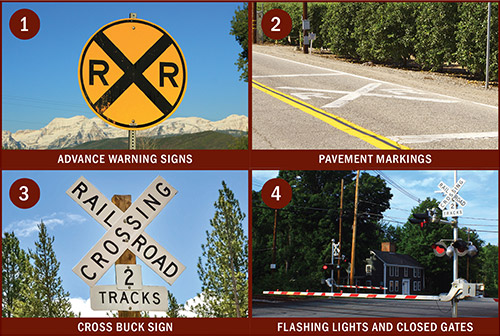This article is from the Summer 2015 issue of The Quill. To view the full issue, visit The Quill archive.
Every commercial motor vehicle (CMV) driver will cross railroad tracks at some point in their career. Training your drivers on the correct procedures for crossing the tracks and the best actions to take in an emergency helps prevent collisions and maintain compliance with federal, state and local regulations.
Warning signs

Make sure your drivers are on the lookout for advance warning signs that indicate a railroad crossing is ahead.
Make sure your drivers are on the lookout for advance warning signs that indicate a railroad crossing is ahead. There are a few different types of signs to watch for.
-
Advance warning signs
Advance warning signs are round, black and yellow and are placed ahead of a public railroad highway crossing. When drivers see this sign, they should slow down, look and listen for a train and be prepared to stop if a train is approaching.
-
Pavement markings
Pavement markings typically show an “X” with the letters “RR” on the road ahead. There is also typically a no-passing marking on two lane roads. The pavement markings also tell drivers that they should slow down, look and listen for a train and be prepared to stop.
-
Cross buck sign
A cross buck sign with or without flashing lights located at the crossing show that drivers are required to yield to approaching trains. A number on the cross buck signs show the number of tracks that the driver needs to cross. When equipped with flashing lights that are activated, prepare to stop before the crossing. When the lights are flashing, the train is too close for you not to stop.
-
Flashing lights and closed gates
Flashing lights and closed gates mean that a train is approaching. Drivers must stop and stay stopped until the gates have risen and the lights stop flashing. Going around closed gates is a violation of local and state laws and a major violation to the Federal Motor Carrier Safety Regulations. See Subpart D, Part 383.51, “Driver Disqualifications and Penalties.” Part 383.51(d) is specific to railroad highway grade crossing offenses.
Approaching the tracks
When approaching a railroad crossing, drivers should start slowing down. Slowing down increases the time that a driver has to look for a train and come to a full stop. Activate four-way flashers to warn other drivers you are slowing down.
Part 392.10 of the Federal Motor Carrier Safety Administration’s (FMCSA) Rules and Regulations provides details on the types of commercial vehicles required to fully stop regardless of whether or not a train is approaching. These vehicles must stop within 50 feet of and not closer than 15 feet to the tracks. Commercial vehicles not listed in part 392.10 must slow down to a speed permitting it to stop when approaching a highway-rail grade crossing but are not required to come to a full stop unless a train is approaching.
Due to the noise inside of trucks, drivers should not expect to hear a train’s horn. Drivers should roll down their windows and turn off any fans or other devices in order to better hear if a train is approaching.
Do not solely rely on warning signs and devices, which may malfunction or not be present at every crossing. Always anticipate a train even if it is not time for a regular run. Just like motor vehicles, trains can experience delays which alter their time schedule.
Crossing the tracks
Drivers should use the highest gear that will let them cross without shifting. As part of your regular pre-trip and en-route vehicle inspections, make sure that the trailer jacks are in the full up position. Non-retracted jacks can cause trucks to be stuck on crossings and/or cause severe damage to the vehicle.
In an emergency
If a truck stalls or becomes stuck on the track, whether or not a train is approaching, there are a few steps drivers should take to help prevent an injury or accident.
Exit the vehicle and call the 800 number posted at the railroad crossing. This emergency phone number directly dials the railroad and is posted on the electrical box or warning sign. Be prepared to provide the location number found on the sign. The driver should also inform local police to alert trains of the truck’s position by dialing 911.
If a train is approaching, drivers should run toward the direction from which the train is coming, but at an angle away from the tracks. This will help prevent drivers from being struck by debris.
Make your safety training more effective by using FMCSA’s railroad crossing safety video, available at www.fmcsa.dot.gov, and the videos, training guides and other resources available from Operation Lifesaver, Inc., a non-profit, international roadway/railroad crossing safety organization, at http://oli.org.